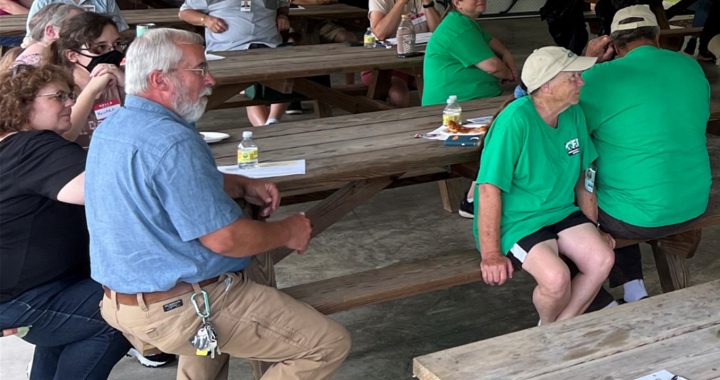The Commonwealth Transportation Board (CTB) approved the FY 2023 Six Year Improvement Program (SYIP) at the June, 2022 meeting. The FY23 SYIP includes funding for seven Transportation Alternatives (TAP) projects around the region, as well as operating and capital grant funding for the public transit and human service transportation providers in the region. TAP grants will fund the construction of sidewalk, intersection, and greenway paths in Augusta County, Bridgewater, Buena Vista, Harrisonburg, and Waynesboro. The transit funding includes an additional year of demonstration grant funding for the Afton Express, allowing for an expansion of the route to serve 12-hour shift workers at the UVA Medical Center in Charlottesville.
Category Archives: News
HRMPO Public Engagement Process to Be Featured at National Conference
Director of Transportation and VAMPO Chair Ann Cundy will present at the National Association of MPOs (AMPO) Annual Conference in October, 2022. Ann will share the conference session with Chet Parsons, Director of Transportation for the Richmond Regional MPO, and Ashley Dobson, Director of Operations and Strategic Communications at Avid Core. The session will focus on post-pandemic public engagement strategies that MPOs of varying sizes can use for any planning process, but particularly on Long Range Transportation Plans. The HRMPO is currently developing the 2045 Long Range Transportation Plan with assistance from Kimley-Horn and Avid Core.
CERT Graduates Volunteers
On May 26, 2022 ten new volunteers graduated from the Staunton-Augusta-Waynesboro Community Emergency Response Team (S-A-W CERT)’s basic training course. CSPDC staff coordinates the S-A-W CERT program for Augusta County and the cities of Staunton and Waynesboro. The Spring 2022 basic training course was the first training offered since the COVID-19 Pandemic began in early 2020.
Since September 2003, the basic CERT course has been offered 39 times, training over 600 people in the Central Shenandoah Region. S-A-W CERT doesn’t just offer the Basic CERT training course; the program has more than 100 active volunteers who meet throughout the year for training, volunteer opportunities, and engagement activities. In June, S-A-W CERT members were excited to finally be able to meet in a large in-person group for the first time in over two years. The next basic CERT training course will start in September 2022. For additional information, please contact Rebecca Joyce at rebecca@cspdc.org or 540.885.5174 ext. 112.
2022 Virginia Outdoors Survey Launched
The Virginia Department of Conservation and Recreation (DCR) has launched the 2022 Virginia Outdoors Survey. Survey findings will help shape the 2023 Virginia Outdoors Plan, a blueprint for the state’s future outdoor recreation programing and infrastructure that is updated every five years. Current Virginia residents are eligible to participate in the survey and responses are due by August 15. Click here to begin the survey.
The Virginia Outdoors Survey provides the opportunity to share your personal preferences and experiences when it comes to outdoor recreation. The survey is a key element of the Virginia Outdoors Plan. Survey responses inform regional recommendations and data, including the most-needed outdoor recreation opportunities and most popular recreation activities in the Central Shenandoah Region. Click here to view the 2018 Virginia Outdoors Plan.
Ag Innovation Center in Buena Vista Awarded ARC Grant
The Ag Innovation Center project, known as the Virginia Innovation Collective, will receive a $700,000 grant through the Appalachian Regional Commission’s (ARC) Area Development Assistance Program. On June 30, Governor Youngkin recommended the project as one of eighteen projects in Virginia for ARC Funding. The grant will support The Advancement Foundation’s redevelopment of a vacant manufacturing building in downtown Buena Vista into a multiuse, business incubation facility. More specifically, the ARC grant will fund the renovation of a commercial kitchen and ADA compliant entrances and restrooms. CSPDC staff provided grant writing assistance for the project. The Advancement Foundation is also the recipient of a GO Virginia grant, supporting entrepreneurial programming and staffing at the Ag Innovation Center.
Rockbridge and Goshen Broadband Projects Close Out
In 2020, the CSPDC was awarded a $2,202,000 VATI grant to bring high-speed internet to areas in Rockbridge County with co-applicant BARC Electric. Construction began December 2020 and ended in April 2022. This project provided broadband access to approximately 470 serviceable units, including 31 businesses in Rockbridge County. Specific areas include Glasgow, South Buffalo, Vesuvius, and Big Hill with a total of 118 miles of fiber. Construction to 22 homes in the Vesuvius area were not completed due to a Blue Ridge Parkway permitting issue. BARC intends to complete construction and serve these 22 homes after the project closeout.
BARC’s 2019 ARC POWER Initiative broadband project in Goshen began construction in April 2021 and completed in November 2022. This project closed out in May 2022 and deployed a high-speed fiber optic broadband network in and around the Town of Goshen. There are 309 serviceable units including about 301 households and 8 businesses and approximately 33 miles of fiber installed for this project. The CSPDC provided grant administration services for this project and the Rockbridge VATI project.
CSPDC Kicks off Data Training Series for Regional Housing Study
The CSPDC recently began a Regional Housing Study in partnership with the Virginia Center for Housing Research (VCHR) and HousingForward Virginia. As part of the study process, VCHR will host a series of data trainings that are available to both CSPDC staff and the region’s local government staff. The purpose of these trainings is to introduce participants to the variety of publicly available data that can be used to assess regional housing issues. Additionally, the trainings hope to empower staff to update data in comprehensive plans, housing studies, and other projects without needing to engage a consultant.
The trainings will be held virtually, and will begin on Thursday, July 14th from 10am-11am, with the first session focusing on American Community Survey and U.S. Census data. The series will span across seven sessions and cover a variety of topics, including economic data, housing affordability data, and MLS and real estate assessment data.
Local government staff interested in attending any of the data training sessions can fill out a registration form here no later than Wednesday, July 13th.
Schedule:
Thursday July 14 – American Community Survey/U.S. Census
Thursday July 21 – Bureau of Labor Statistics (BLS)/Jobs EQ
Thursday July 28 – Comprehensive Housing Affordability Strategy (CHAS) Data
Thursday August 4 – Public Use Microdata Sample (PUMS) Data #1
Thursday August 11 – PUMS #2
[BREAK]
TBD – MLS Data
TBD – Assessment
Dayton Receives CDBG Planning Grant
The Town of Dayton received a Community Development Block Grant from the Virginia Department of Housing and Community Development to develop a downtown revitalization plan that will guide the Town’s efforts to reenergize Downtown Dayton. Through this process, the Town hopes to create a collaborative vision for transforming Downtown Dayton into a year-round destination through streetscaping, local business, and pedestrian-oriented development.
To kick off the planning process, the Town will hold a public meeting later this Summer that will introduce the project and gather community input to guide the vision for the Downtown. Throughout the Summer, a Project Management Team will be formed and a physical inventory of buildings and open spaces in Downtown Dayton will be completed to establish a foundation for the full planning process that will be started in the Fall. The CSPDC is providing grant writing services and grant administration support.
Afton Express Experiencing Increased Ridership
The Afton Express has seen an increase in ridership as gas prices remain high. Ridership has been steadily growing since the service launched in September of 2021, but has really taken off in the last few months. From February to May, the CSPDC saw passenger counts increase by about 5% each month as more people learn of the service. From May to June that number jumped to 25%. As of June, the Afton Express sees between 45 and 50 passenger trips per day Monday through Thursday. Ridership is slightly lower on Friday, as people may take vacation, or may drive their own car to get a head start on their weekend plans.
CSPDC Planners attribute the increase in ridership to several factors. Gas prices are likely a factor. Additionally, more employees are transitioning back to an in-person work schedule. And finally, the partnership with the University of Virginia’s Parking and Transportation Office has made it easier for UVA employees to purchase Afton Express farecards.
An expansion of the service is planned for the fall of 2022. The CSPDC seeks to add an additional run in the evening that would allow the Afton Express to better serve hospital staff who work 12-hour shifts and get off work later than the service currently runs.
For more information about the Afton Express, visit www.aftonexpress.org
Bath-Highland Network Authority Public Meeting
On July 11, 2022, at 1:00 p.m., the Bath-Highland Network Authority will hold a meeting at the Bolar Ruritan Club, 38 Bolar Ln Monterey, VA 24465. For more information about the meeting, please contact Ms. Hunter Moore at 540-885-5174 or hunter@cspdc.org.







